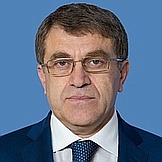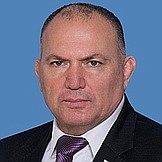Regional flags and emblems


PROFILE
Established: 12 January 1922 as the Karachayevo-Circassian Autonomous Region; since July 1991 – Karachayevo-Circassian SSR as part of the RSFSR; since 1992 – Karachayevo-Circassian Republic
Capital: Cherkessk
The Karachayevo-Circassion Republic is part of the North Caucasian Federal District
Area: 14,300 sq km
Population: 468 500 (2025)
Ethnic groups
(2020 National Census, %)
Karachai – 44,38
Russian – 27,55
Circassian – 12,70
Abazin – 8,13
Nogai – 3,75
Other – 3,49
The Karachayevo-Circassian Republic is multi-ethnic, more than 80 ethnic groups are represented here.
Administrative divisions (2024)
Municipal districts – 10
City districts − 2
Rural towns − 5
Rural districts − 83
Geography and climate
The republic is located in the northwestern part of the foothills of the Caucasus.
It borders with the Kabardino-Balkarian Republic, Stavropol and Krasnodar regions as well as with (territorial borders) Abkhazia and Georgia.
By terrain, the republic is divided into three parts: flat, foothill and mountain. Mountains occupy about 80 % of the territory. The highest peak of Europe, Elbrus (5,642 m), is located here on the border with the Kabardino-Balkarian Republic.
The climate is moderately continental and arid. The coldest month is January (the average temperature is from −2,6°С in the mountain regions up to −5°С in the foothills); the warmest month is July (the average temperature is up to +21°С in the foothills and up to +8°С in the mountains).
There are several specially protected areas: the Teberda State Nature Biosphere Reserve; the western part of the Caucasian State Nature Biosphere Reserve, and part of the specially protected environmental and resort region of the Russian Federation − Caucasian Mineral Waters; the Dautsky State Federal Sanctuary (zoological), 8 state regional nature reserves as well as over 70 natural monuments in the region. Tourist and recreational area of Dombai-Arkhyz can be found here as well.
The Great Stavropol Canal supplies water to the Stavropol Territory.
Government
The legislative branch in the Karachayevo-Circassian Republic is represented by the People's Assembly (Parliament) of the Karachayevo-Circassian Republic, which is the permanent and only body of legislative and representative authority in the republic.
The People's Assembly (Parliament) of the Karachayevo-Circassian Republic consists of 50 deputies who are elected for five years in the republican electoral district, where winners are identified in proportion to the number of votes cast for lists of candidates nominated by electoral associations.
The current People's Assembly (Parliament) of the Karachayevo-Circassian Republic was elected in September 2024. Its term expires in September 2029.
Executive power in the Karachayevo-Circassian Republic is exercised by the Head of the Karachayevo-Circassian Republic, the Government of the Karachayevo-Circassian Republic, and other executive bodies of state power of the republic.
The Head of the Karachayevo-Circassian Republic is the republic’s highest-ranking official and the head of the republic’s executive branch of government. The Head of the Karachayevo-Circassian Republic is elected by the People’s Assembly (Parliament) of the Karachayevo-Circassian Republic for five years. The term of office of the current Head of the Republic expires in September 2026.
The Government of the Karachayevo-Circassian Republic is the supreme permanent executive authority of the republic. The republic’s Government is formed by and is accountable to the Head of the Karachayevo-Circassian Republic. The Prime Minister of the Republic is appointed by the Head of the Karachayevo-Circassian Republic.
Economy and natural resources
The Karachayevo-Circassian Republic is an industrial and agrarian region with conditions suitable for the development of mountain tourism and the recreational industry.
The main contributors to the republic’s regional GDP are industrial production, the agro-industrial complex, wholesale and retail trade and the construction industry.
The share of industry in the makeup of the regional GDP is about 20%. The leading role in industrial production belongs to processing industries (accounting more than 60% in the volume of shipped goods of domestic production, works and services), production and distribution of electricity, gas and water (more than 26%), as well as mining (about 7%).
Processing industries are represented by ferrous and non-ferrous metallurgy (Urupsky MMC, Zelenchuksky MMC), chemical and petrochemical industries (Selena-Khimvolokno, Khabez Gypsum Plant ), and the food industry (Mercury, Saturn, Corporation KAMOS, Karachayevo-Circassian Mukomol, Yuzhny Agrocombine, Aqualine), machine building (NVA, Kholodmash), and the construction materials industry (Kavkazcement, Habez Alabaster Plant, and Karachayevo-Circassian Silicate Brick Plant). The majority of industrial enterprises are located in Cherkessk, Karachayevsk and Teberda.
The production and distribution of electricity, gas and water are carried out by the energy complex, which is comprised of thermal power stations, heat and power stations and hydroelectric power stations (RusHydro − Cascade of Zelenchuksk Hydroelectric Power Station − Grid Energy Storage). The shortage of electricity is an acute problem for the republic. Most of Karachayevo-Circassia’s energy needs are met by other regions of the country. The republic is 80% gasified.
At the core of the mining industry are the region’s explored deposits of tungsten, copper-pyrite ores, zinc (Khudesskoye deposit), coal, various facing stones and basalts for the production of mineral fibers. Nonmetallic materials, cement raw materials and gypsum are available in the region in large amounts and serve as a good raw material base for the intensive development of the construction materials industry in the republic. In Karachayevo-Circassia, there are significant and diverse reserves of high-quality underground mineral waters.
In addition, the wood processing, pulp and paper, consumer goods industry and pharmaceutical industry are developed in the region.
The agro-industrial complex’s share in the regional GDP is about 20%. The agro-climatic conditions of the republic were beneficial to the development of agriculture with specialisation in livestock breeding, the growing of vegetables, and the production of grain crops. An important branch of agriculture is horse breeding and wool production. In Karachayevo-Circassia, the most valuable Karachai sheep is bred, and here such primary agricultural raw materials as leather, fur and jute are processed.
The fastest growing segments of the region’s agriculture include crop production such as grains (rye, wheat, barley, oats, buckwheat, corn), soya, sunflower, sugar beet, potatoes and other vegetables; horticulture – the cultivation of fruits and nuts; livestock, including meat and dairy cattle breeding, range sheep industry, poultry farming, and pedigree cattle breeding.
Culture and tourism
Karachayevo-Circassia is one of the most beautiful places in our country. Nature awarded it with unique sights. The entire mountainous part of the republic is a resort area, including such pearls as Dombai, Teberda, Arkhyz, Western Elbrus and high-altitude plateaus Biichesyn and Bermamyt.
Dombai is a famous ski resort and the centre of mountaineering and tourism in the Caucasus, which is famous for its magnificent landscapes, alpine lakes, waterfalls and a Narzan spring.
The primeval nature and picturesque landscapes attract tourists to the resort town Teberda. This is one of the centres for spa treatments in the region. There are several tourist centres and resorts, where modern equipment, the latest technologies and methods are used to treat patients.
In recent years, the Arkhyz tourist and recreational complex has been developing in the republic. It is the start site of the North Caucasian tourist cluster. The project for the development of the Arkhyz world-class all-season ski resort is one of the largest investment projects of Russian and foreign businesses in the North Caucasus. In winter, there are ski slopes of varying degrees of complexity, and in summer, visitors can ride in cable cars, enjoying the magnificence of mountain landscapes from a height of more than 2,000 metres.
On the northern slopes of the Main Caucasian Range, facing Arkhyz, glaciers are visible − Sofiisky, Psyshsky and Bolshoi Kizgichisky. In the Lower Arkhyz area, at an altitude of more than 2,000 metres above sea level, the most powerful special astrophysical observatory in Russia is located, which is the largest Russian astronomical centre for ground-based observations of objects of the universe.
The Karachayevo-Circassian State Historical, Cultural and Natural Museum-Reserve combines in one place a unique complex of monuments and their territories, which are interconnected historically, ethnically, architecturally and in terms of landscape. There are ruins of over 80 medieval towns and settlements, over 5,000 mounds, necropolises and individual burial sites of various eras, pagan sanctuaries, as well as some of the most ancient Christian churches in Russia.


